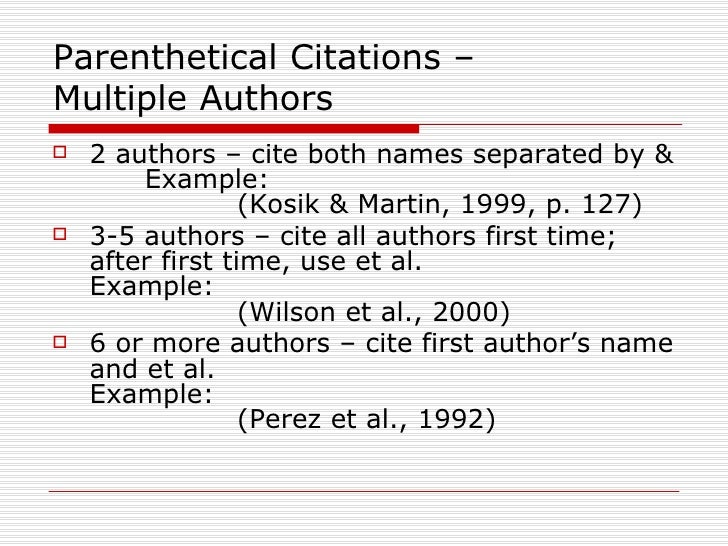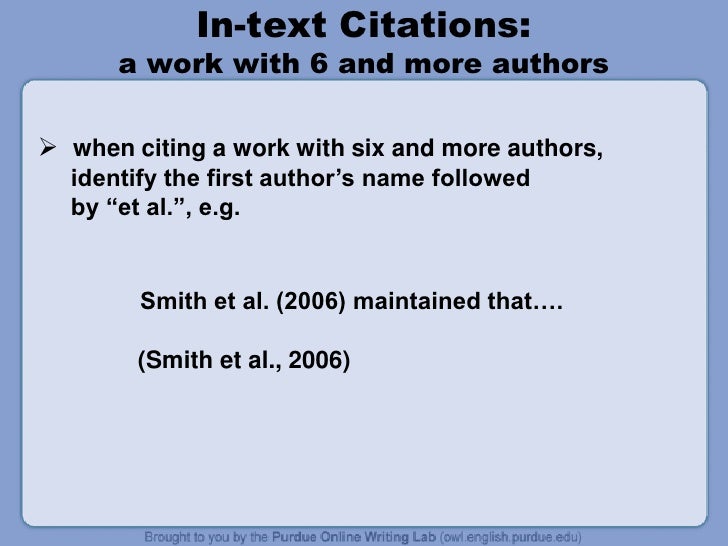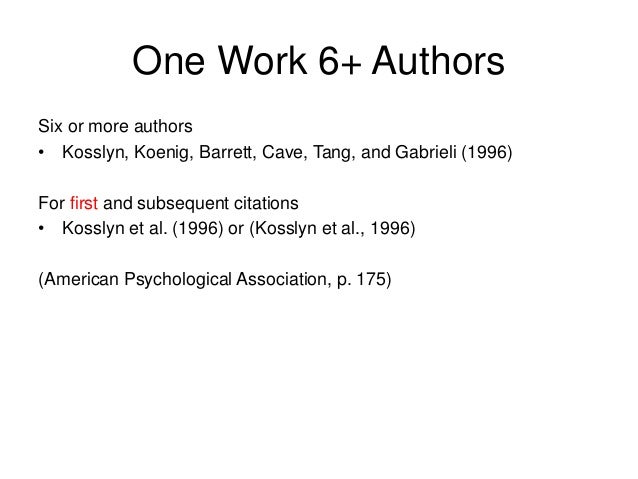Et al meaning in citation information
Home » Trend » Et al meaning in citation informationYour Et al meaning in citation images are ready in this website. Et al meaning in citation are a topic that is being searched for and liked by netizens today. You can Find and Download the Et al meaning in citation files here. Get all royalty-free images.
If you’re looking for et al meaning in citation images information related to the et al meaning in citation keyword, you have come to the ideal blog. Our website always gives you hints for seeking the maximum quality video and image content, please kindly hunt and locate more informative video content and images that match your interests.
Et Al Meaning In Citation. Often appears in academic documents. (alberto, jacobi & keating, 1993) for the first citation and (alberto et al., 1993) in subsequent citations. Only include the first author’s last name, followed by “et al.”, a comma and the year of publication, for example (taylor et al., 2018). Is an abbreviation for et alia (neuter plural).
 How to Use Internal Citations (with Pictures) wikiHow From wikihow.com
How to Use Internal Citations (with Pictures) wikiHow From wikihow.com
Often appears in academic documents. The ”al” in “et al.” is always followed by a full stop. The term ‘‘et al.’’ is the abbreviated form of the latin term ‘‘et alia,’’ which means ‘‘and others.’’. When the authors� names are not mentioned in the text, the citation consists of the first author�s Ibid., op cit., et al. Typically stands in for two or more names, especially in bibliographical information.
It is used in academic citations for sources that have multiple authors.
Typically stands in for two or more names, especially in bibliographical information. It’s party time (smith et al., 2002). “et al.” is a latin term and the short form of “et alia”, which literally means ”and others”. Is an abbreviation for et alia (neuter plural). It is used in academic citations for sources that have multiple authors. But it can also be an abbreviation for et alii (masculine plural), or et aliae (feminine plural).
 Source: slideshare.net
Source: slideshare.net
One of these is the latin phrase et al., an abbreviation meaning “and others.” it is used to shorten lists of author names in text citations to make repeated referencing shorter and simpler. “et al.” is a latin term and the short form of “et alia”, which literally means ”and others”. (from the latin et alii) means and others. et al. It is used to shorten lists of author names in text citations to make repeated referencing shorter and simpler. (but not after the t).
 Source: slideserve.com
Source: slideserve.com
Ibid., op cit., et al. This phrase means “and others.” Often appears in academic documents. However, the 7 th edition of apa citation differs from previous versions in how “et al.” is applied. Is most commonly used in bibliographic citations and in informal or technical writing to suggest the logical continuation of a list of people (not, as a general rule, of things).
 Source: report574.web.fc2.com
Source: report574.web.fc2.com
It is used in academic citations for sources that have multiple authors. Then, for subsequent citations of the same source, you can simply cite the first listed author and ‘et al.’: (note that this rule has changed from apa 6 guidelines on using et al., which recommend listing all author names in the first citation up to five authors but then using et al. for the second and subsequent citations.) (latin terms in referencing) if you want to sound smart and/or pretentious, dropping the odd latin phrase into conversation is a good way to go. Is an abbreviation for et alia (neuter plural).
 Source: mendeley.com
Source: mendeley.com
When the authors� names are not mentioned in the text, the citation consists of the first author�s In a citation, et al. One of these is the latin phrase et al., an abbreviation meaning “and others.” it is used to shorten lists of author names in text citations to make repeated referencing shorter and simpler. Most of the time, though, latin isn’t how we communicate these days. Full stop after �al.� not after �et�.
 Source: study.com
Source: study.com
One of these is the latin phrase et al., an abbreviation meaning “and others.” it is used to shorten lists of author names in text citations to make repeated referencing shorter and simpler. A period belongs after the l in et al. More than seven), some systems recommend using ‘et al.’ for the first citation. It�s preceded by a comma only when more than one name is listed (as in cases in which two or. Only include the first author’s last name, followed by “et al.”, a comma and the year of publication, for example (taylor et al., 2018).
 Source: seogatame.blogspot.com
Source: seogatame.blogspot.com
The term ‘‘et al.’’ is the abbreviated form of the latin term ‘‘et alia,’’ which means ‘‘and others.’’. Ibid., op cit., et al. “et al.” is short for the latin term “et alia,” meaning “and others.” it is used in academic citations when referring to a source with multiple authors: In apa 7, for a work with three or more authors, list the first author and “et al.” for all citations, including the first citation, unless doing so would create ambiguity. Followed by the phrase et al. (which means and others).
 Source: seogatame.blogspot.com
Source: seogatame.blogspot.com
Full stop after �al.� not after �et�. Followed by the phrase et al. (which means and others). It is used to shorten lists of author names in text citations to make repeated referencing shorter and simpler. (note that this rule has changed from apa 6 guidelines on using et al., which recommend listing all author names in the first citation up to five authors but then using et al. for the second and subsequent citations.) If a source has a lot of authors (e.g.
 Source: slike24.blogspot.com
Source: slike24.blogspot.com
The ”al” in “et al.” is always followed by a full stop. In apa 7, for a work with three or more authors, list the first author and “et al.” for all citations, including the first citation, unless doing so would create ambiguity. More than seven), some systems recommend using ‘et al.’ for the first citation. Often appears in academic documents. It is generally used in footnotes and citations:
 Source: tex.stackexchange.com
Source: tex.stackexchange.com
“et al.” is short for the latin term “et alia,” meaning “and others.” it is used in academic citations when referring to a source with multiple authors: Ibid., op cit., et al. (alberto, jacobi & keating, 1993) for the first citation and (alberto et al., 1993) in subsequent citations. It�s preceded by a comma only when more than one name is listed (as in cases in which two or. Full stop after �al.� not after �et�.
 Source: researchgate.net
Source: researchgate.net
(but not after the t). Indicates that multiple authors are being cited within a reference in an academic work but that not all of their names are listed. For example, when a book has multiple authors, et al. (but not after the t). A period belongs after the l in et al.
 Source: slideshare.net
Source: slideshare.net
It is used to shorten lists of author names in text citations to make repeated referencing shorter and simpler. Most of the time, though, latin isn’t how we communicate these days. (latin terms in referencing) if you want to sound smart and/or pretentious, dropping the odd latin phrase into conversation is a good way to go. (but not after the t). Ibid., op cit., et al.

It is generally used in footnotes and citations: Is an abbreviation for et alia (neuter plural). Other punctuation marks, such as a comma, can follow the full stop after ”al”. “et al.” is short for the latin term “et alia,” meaning “and others.” it is used in academic citations when referring to a source with multiple authors: In apa style, for a source with three or more authors, list the first author’s last name and “et al.” for all citations, including the first citation.
 Source: seogatame.blogspot.com
Source: seogatame.blogspot.com
When the authors� names are not mentioned in the text, the citation consists of the first author�s One of these is the latin phrase et al., an abbreviation meaning “and others.” it is used to shorten lists of author names in text citations to make repeated referencing shorter and simpler. A period belongs after the l in et al. Ibid., op cit., et al. Only include the first author’s last name, followed by “et al.”, a comma and the year of publication, for example (taylor et al., 2018).
 Source: slideshare.net
Source: slideshare.net
Is an abbreviation for et alia (neuter plural). Often appears in academic documents. A period belongs after the l in et al. In a citation, et al. It is used to shorten lists of author names in text citations to make repeated referencing shorter and simpler.
 Source: wikihow.com
Source: wikihow.com
The phrase et al in a bibliography or other citation simply means and others. this phrase comes about as an abbreviation of a phrase in latin. Then, for subsequent citations of the same source, you can simply cite the first listed author and ‘et al.’: Typically stands in for two or more names, especially in bibliographical information. “et al.” is short for the latin term “et alia,” meaning “and others.” it is used in academic citations when referring to a source with multiple authors: Ibid., op cit., et al.
 Source: wikihow.com
Source: wikihow.com
More than seven), some systems recommend using ‘et al.’ for the first citation. Is an abbreviation for et alia (neuter plural). Followed by the phrase et al. (which means and others). When the authors� names are not mentioned in the text, the citation consists of the first author�s For example, when a book has multiple authors, et al.
 Source: gajahmatiyo.blogspot.com
Source: gajahmatiyo.blogspot.com
(note that this rule has changed from apa 6 guidelines on using et al., which recommend listing all author names in the first citation up to five authors but then using et al. for the second and subsequent citations.) (note that this rule has changed from apa 6 guidelines on using et al., which recommend listing all author names in the first citation up to five authors but then using et al. for the second and subsequent citations.) It�s preceded by a comma only when more than one name is listed (as in cases in which two or. It is used in academic citations for sources that have multiple authors. “et al.” is a latin term and the short form of “et alia”, which literally means ”and others”.
 Source: itread01.com
Source: itread01.com
Can be used after the first name to indicate that there are more than two other authors who worked on the project. It is generally used in footnotes and citations: (alberto, jacobi & keating, 1993) for the first citation and (alberto et al., 1993) in subsequent citations. The ”al” in “et al.” is always followed by a full stop. Most of the time, though, latin isn’t how we communicate these days.
This site is an open community for users to do sharing their favorite wallpapers on the internet, all images or pictures in this website are for personal wallpaper use only, it is stricly prohibited to use this wallpaper for commercial purposes, if you are the author and find this image is shared without your permission, please kindly raise a DMCA report to Us.
If you find this site adventageous, please support us by sharing this posts to your own social media accounts like Facebook, Instagram and so on or you can also bookmark this blog page with the title et al meaning in citation by using Ctrl + D for devices a laptop with a Windows operating system or Command + D for laptops with an Apple operating system. If you use a smartphone, you can also use the drawer menu of the browser you are using. Whether it’s a Windows, Mac, iOS or Android operating system, you will still be able to bookmark this website.
Category
Related By Category
- De vliegeraar citaten information
- Full reference citation apa style information
- Free apa citation machine online information
- Etre amoureux citation information
- Fight club citation tyler information
- Evene lefigaro fr citations information
- Freud citations aimer et travailler information
- Endnote book citation information
- Flap lever cessna citation information
- Foreign aid debate citation information